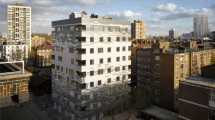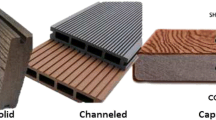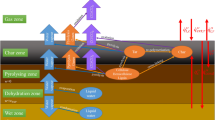Abstract
Densified Pinus sylvestris wood was prepared via densification treatment at different compression pressures, and the flame retardancy and heat-insulating property of the resulting densified Pinus sylvestris wood are investigated by various analytical methods. The results verify that the densification treatment has a negligible effect on the composition and chemical structures of the wood, while the flame retardancy, smoke suppression and heat-insulating properties of wood are significantly increased. However, an excessive compression pressure will destroy the porous structure of wood, which results in the decrease in flame-retardant efficiency of the densified wood. When the compression pressure reaches 10 MPa, the resulting specimen presents the lowest fire hazard, which has 9.8% reduction in total heat release (THR), 37.1% reduction in total smoke release (TSR) and 25.9% reduction in equilibrium backside temperature at 2400 s compared to natural wood. Char formation analysis shows that the enhanced flame retardancy of densified wood can be attributed to a lower contact area between the wood and high-temperature environment accompanied with the generation of a strong and thermally stable char layer rich in aromatic and cross-linking structures. These attractive features of densified wood effectively reduce the transfer of heat and combustion rates when exposed to flame, resulting in better fire-retardant and heat-insulating properties during combustion.










Similar content being viewed by others
References
Candan Z, Korkut S, Unsal O (2013) Thermally compressed poplar wood (TCW): physical and mechanical properties. Drvna Ind 64(2):107–111. https://doi.org/10.5552/drind.2013.1216
Chen HL, Carlo F, Marco A et al (2010) Qualitative and quantitative analysis of wood samples by Fourier transform infrared spectroscopy and multivariate analysis. Carbohydrate Polymer 82(3):772–778. https://doi.org/10.1016/j.carbpol.2010.05.052
Chen GG, Chen CJ, Pei Y et al (2019) A strong, flame-retardant, and thermally insulating wood laminate. Chem Eng J 383:123109. https://doi.org/10.1016/j.cej.2019.123109
Fan Q, Ou RX, Hao XL et al (2022) Water-induced self-assembly and in situ mineralization within plant phenolic glycol-gel toward ultrastrong and multifunctional thermal insulating aerogels. ACS Nano. https://doi.org/10.1021/acsnano.2c00755
Fu QL, Medina L, Li YY et al (2017) Nanostructured wood hybrids for fire-retardancy prepared by clay impregnation into the cell wall. ACS Appl Mater Interfaces 9(41):36154–36163. https://doi.org/10.1021/acsami.7b10008
Gan W, Chen C, Wang Z et al (2018) Dense, self-formed char layer enables a fire-retardant wood structural material. Adv Func Mater 29:1807444. https://doi.org/10.1002/adfm.201807444
Guo BT, Liu YZ, Zhang Q et al (2017) Efficient flame-retardant and smoke-suppression properties of Mg-Al-layered double-hydroxide nanostructures on wood substrate. ACS Appl Mater Interfaces 9(27):23039–23047. https://doi.org/10.1021/acsami.7b06803
Guo HZ, Lukovic M, Mendoza M et al (2019) Bioinspired struvite mineralization for fire-resistant wood. ACS Appl Mater Interfaces 11(5):5427–5434. https://doi.org/10.1021/acsami.8b19967
Kačíková D, Kubovský I, Eštoková A et al (2021) The influence of nanoparticles on fire retardancy of pedunculate oak wood. Nanomaterials 11(12):3405. https://doi.org/10.3390/nano11123405
Kutnar A, Sandbery D, Haller P (2015) Compressed and moulded wood from processing to products: COST action FP0904 2010–2014: thermo-hydro mechanical wood behaviour and processing. Holzforschung 69(7):885–897. https://doi.org/10.1515/hf-2014-0187
Laine K, Rautkari L, Hughes M et al (2013a) Reducing the set-recovery of surface densified solid Scots pine wood by hydrothermal post-treatment. Eur J Wood Prod 71:17–23. https://doi.org/10.1007/s00107-012-0647-2
Laine K, Belt T, Rautkari L et al (2013b) Measuring the thickness swelling and set-recovery of densified and thermally modified Scots pine solid wood. J Mater Sci 48:8530–8538. https://doi.org/10.1007/s10853-013-7671-4
Laine K, Segerholm K, Walinder M et al (2016) Wood densification and thermal modification: hardness, set-recovery and micromorphology. Wood Sci Technol 50:883–894. https://doi.org/10.1007/s00226-016-0835-z
Merk V, Chanana M, Keplinger T et al (2015) Hybrid wood materials with improved fire retardance by bio-inspired mineralisation on the nano- and submicron level. Green Chem 17:1423–1428. https://doi.org/10.1039/c4gc01862a
Mertoglu EG, Yılgor N (2020) Chemical and thermal characterizations of Pinus sylvestris and Pinus pinaster. BioResources 15(2):3604–3620. https://doi.org/10.15376/biores.15.2.3604-3620
Nikolic M, Lawther JM, Sanadi AR (2015) Use of nanofillers in wood coating: a scientific review. J Coat Technol Res 12:445–461. https://doi.org/10.1007/s11998-015-9659-2
Olesheimer LJ (1929) Compressed laminated fibrous product and process of making the same. U S Patent No. 1707135
Papadopoulos AN, Bikiaris DN, Mitropoulos AC et al (2019) Nanomaterials and chemical modifications for enhanced key wood properties: a review. Nanomaterials 9:607. https://doi.org/10.3390/nano9040607
Pařil P, Brabec M, Maňák O et al (2014) Comparison of selected physical and mechanical properties of densified beech wood plasticized by ammonia and saturated steam. Eur J Wood Prod 72:583–591. https://doi.org/10.1007/s00107-014-0814-8
Popescu C, Pfriem A (2019) Treatments and modification to improve the reaction to fire of wood and wood based products—an overview. Fire Mater 44(1):100–111. https://doi.org/10.1002/fam.2779
Rana R, Langerfeld-Heyser R, Finkeldey R et al (2010) FTIR spectroscopy, chemical and histochemical characterisation of wood and lignin of five tropical timber wood species of the family of Dipterocarpaceae. Wood Sci Technol 44:225–242. https://doi.org/10.1007/s00226-009-0281-2
Rautkari L, Laine K, Laflin N et al (2011) Surface modification of Scots pine: the effect of process parameters on the through thickness density profile. J Mater Sci 46:4780–4786. https://doi.org/10.1007/s10853-011-5388-9
Sun Q, Yu H, Liu Y et al (2010) Prolonging the combustion duration of wood by TiO2 coating synthesized using cosolvent-controlled hydrothermal method. J Mater Sci 45:6661–6667. https://doi.org/10.1007/s10853-010-4758-z
Tsioptsias C, Panayiotou C (2011) Thermal stability and hydrophobicity enhancement of wood through impregnation with aqueous solutions and supercritical carbon dioxide. J Mater Sci 46:5406–5411. https://doi.org/10.1007/s10853-011-5480-1
Walsh FL, Watts RL (1923) Composite lumber. U S Patent No.1465383
Wang J, Zhao M (2020) Study on the effects of aging by accelerated weathering on the intumescent fire retardant coating for steel elements. Eng Fail Anal 118:104920. https://doi.org/10.1016/j.engfailanal.2020.104920
Wang QW, Li J, Winandy JE (2004) Chemical mechanism of fire retardance of boric acid on wood. Wood Sci Technol 38:375–389. https://doi.org/10.1007/s00226-004-0246-4
Wang FY, Liu H, Yan L et al (2021) Comparative study of fire resistance and anti-ageing properties of intumescent fire-retardant coatings reinforced with conch shell bio-filler. Polymer 13(16):2620. https://doi.org/10.3390/polym13162620
Wang FY, Liu H, Yan L (2022) Fabrication of polypyrrole-decorated tungsten tailing particles for reinforcing flame retardancy and ageing resistance of intumescent fire-resistant coatings. Polymers 14(8):1540. https://doi.org/10.3390/polym14081540
Xu GY, Cheng JY, Wu HY et al (2012) Functionalized carbon nanotubes with oligomeric intumescent flame retardant for reducing the agglomeration and flammability of poly(ethylene vinyl acetate) nanocomposites. Polym Compos 34(1):109–121. https://doi.org/10.1002/pc.22382
Zhu FL, Xin Q, Feng QQ et al (2016) Influence of nano-silica on flame resistance behavior of intumescent flame retardant cellulosic textiles: remarkable synergistic effect? Surf Coat Technol 294:90–94. https://doi.org/10.1016/j.surfcoat.2016.03.059
Funding
This study was funded by the National Natural Science Foundation of China (No. 51906261), the Key Research and Development Program of Hunan Province (No. 2021SK2054) and the High-Tech Industry Science and Technology Innovation Leading Plan of Hunan Province (No.2020GK2079).
Author information
Authors and Affiliations
Contributions
All authors contributed to the study conception and design. ZX: Methodology, conception, writing—review and editing; WZ: investigation, formal analysis, validation, data curation, writing—original draft preparation; YF: methodology, validation; XT: data curation; LY: writing—review and editing, supervision, project administration. All authors have read and agreed to the published version of the manuscript.
Corresponding author
Ethics declarations
Conflict of interest
The authors have no conflicts of interest to declare that are relevant to the content of this article.
Additional information
Publisher's Note
Springer Nature remains neutral with regard to jurisdictional claims in published maps and institutional affiliations.
Supplementary Information
Below is the link to the electronic supplementary material.
Rights and permissions
About this article
Cite this article
Xu, Z., Zhao, W., Feng, Y. et al. Flame-retardant, heat-insulating and char formation properties of densified Pinus sylvestris treated with different compression pressures. Eur. J. Wood Prod. 80, 1321–1331 (2022). https://doi.org/10.1007/s00107-022-01859-7
Received:
Accepted:
Published:
Issue Date:
DOI: https://doi.org/10.1007/s00107-022-01859-7




